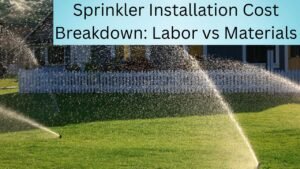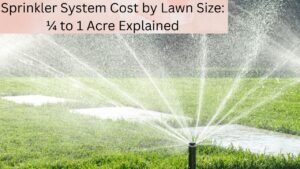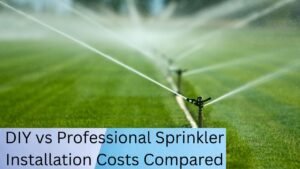If you’re considering upgrading your Wichita lawn with a new sprinkler system, you’re likely wondering about the sprinkler system installation cost Wichita homeowners can expect. Installing a sprinkler system not only enhances your lawn’s health but also saves you time and effort.
In this guide, we’ll break down the costs associated with sprinkler system installation in Wichita, Kansas, explore the factors influencing these costs, and provide guidance on finding a reputable installer. Let’s dive into the details!

Understanding the Average Cost of Sprinkler System Installation
I break down the costs of installing a sprinkler system, from materials to labor, so you can budget effectively. The article How Much Does Sprinkler System Installation Cost? by CountyOffice.org (published about 4 months ago) outlines pricing factors and typical ranges for homeowners. Check for youtube video below:
When planning a sprinkler system installation in Wichita, the average cost typically ranges between $2,000 and $5,000. This range reflects the variance in system types, lawn sizes, and installation complexities.
Here’s a detailed breakdown to help you understand where your money goes:
Cost Breakdown by System Type
| System Type | Average Cost | Components |
|---|---|---|
| Basic System | $2,000 – $3,000 | Standard sprinkler heads, basic timers, minimal zone coverage. Suitable for smaller lawns. |
| Mid-Range System | $3,000 – $4,000 | Efficient sprinkler heads, programmable controllers, additional zones. Ideal for medium to large lawns. |
| High-End System | $4,000 – $5,000 | Premium materials, smart controllers, advanced irrigation technologies. Best for extensive or complex landscapes. |
Basic System: Typically includes standard spray heads and a simple timer. This option is budget-friendly and works well for small, straightforward lawns. However, it may lack features that optimize water use and coverage.
Mid-Range System: Offers more efficiency with rotary heads and a programmable controller. This system provides better coverage and water management for medium to large lawns, allowing for customized watering schedules.
High-End System: Incorporates advanced technology such as smart controllers with weather sensors. This system uses high-quality materials and sophisticated irrigation techniques, ensuring optimal water distribution and efficiency for large or intricate landscapes.
Potential Add-Ons:
- Smart Home Integration: Allows remote control of the system via a smartphone app.
- Advanced Irrigation Techniques: Includes drip irrigation or rain sensors, which can further enhance water efficiency and reduce waste.
Factors Influencing the Cost of Sprinkler System Installation
Several factors can impact the overall cost of installing a sprinkler system. Understanding these elements will help you budget more effectively and make informed decisions.
1. Size of the Lawn
The size of your lawn plays a crucial role in determining the cost. Larger lawns require more sprinkler heads, piping, and installation time, which translates to higher costs. For instance, a small lawn might need fewer zones and less piping compared to a sprawling estate.
2. Type of Sprinkler System
Different types of sprinkler systems come with varying price tags:
- Drip Irrigation Systems: Ideal for garden beds or areas with specific watering needs, though they are generally more expensive.
- Spray Systems: Cost-effective for smaller to medium-sized lawns, providing good coverage but less efficiency compared to rotary systems.
- Rotary Systems: Suitable for larger lawns, offering even water distribution and better coverage, which can justify a higher price.
3. Complexity of Installation
Complex installations involve factors like extensive excavation, custom adjustments, or challenging landscape features.
These complexities require more labor and materials, increasing the overall cost. Additionally, features like multiple zones or advanced water-saving options can add to the complexity and cost.
4. Labor Costs
Labor costs in Wichita typically range from $50 to $100 per hour. The total cost will depend on the complexity of the installation and the number of hours required.
Experienced installers may charge higher rates but can often complete the job more efficiently.
5. Materials Costs
Material quality significantly affects the cost. High-quality pipes, advanced sprinkler heads, and sophisticated controllers can drive up the price. Investing in durable and efficient materials can pay off in the long run by reducing maintenance and operational costs.
6. Permits
Local regulations may require permits for installing a sprinkler system. In Wichita, permit fees generally range from $50 to $200, depending on the project scope and requirements. Always check with local authorities to ensure compliance with regulations.
7. Backflow Prevention Devices
To prevent contamination of your water supply, backflow prevention devices are often required. These devices typically cost between $100 and $300 and are essential for maintaining water safety and system compliance.
How to Find a Reputable Sprinkler System Installer
I walk through what’s involved in a full sprinkler system installation. The youtube video below Sprinkler System Install – Overview by Sprinkler Warehouse (YouTube, April 18, 2019) covers each step, from layout planning to final adjustments, giving homeowners a clear idea of what to expect.
Finding a reliable Sprinkler System Installer in Wichita is key to ensuring a successful sprinkler system installation.
Here are steps to help you choose the right professional:
1. Get Recommendations
Start by asking friends, family, or neighbors for recommendations. Personal referrals can provide valuable insights into the quality and reliability of local installers.
2. Check Online Reviews
Research online reviews on platforms like Yelp, Google, and Angie’s List. Look for feedback on customer service, workmanship, and overall satisfaction. Positive reviews can indicate a trustworthy installer.
3. Get Multiple Quotes
Request quotes from at least three different installers. Comparing quotes will give you a better understanding of the market rate and help you identify any unusual pricing.
4. Ask About Experience and Qualifications
Ensure the installer has relevant experience and qualifications. Request examples of previous projects similar to yours and verify their expertise in handling various sprinkler system installations.
5. Verify Licensing and Insurance
Confirm that the installer is licensed and insured. This not only ensures compliance with local regulations but also protects you from potential liabilities.
6. Watch for Red Flags
Be cautious of installers who offer unusually low prices, use high-pressure sales tactics, or refuse to provide a written contract. A detailed contract should outline the scope of work, materials, and payment terms to avoid misunderstandings.
Environmental Considerations
When installing a sprinkler system, consider environmentally friendly options to minimize water waste:
- Water-Saving Technologies: Implement drip irrigation or smart controllers to optimize water usage and reduce waste.
- Avoid Over-Watering: Use rain sensors or soil moisture sensors to adjust watering based on actual needs, preventing over-watering and conserving water.
Conclusion
Installing a sprinkler system in Wichita can greatly enhance the health and appearance of your lawn while saving you time and effort.
To get the best value for your investment, it’s smart to explore all the factors that influence pricing—from lawn size to smart tech upgrades. Our full Sprinkler System Cost Guide breaks down these details across various regions and system types, helping you plan smarter.
By understanding the costs involved and working with a reputable installer, you’ll set yourself up for a system that performs well and lasts.
Ready to upgrade your lawn? Contact a local sprinkler system installer today for a customized quote and start enjoying the benefits of a professionally designed and installed sprinkler system.




